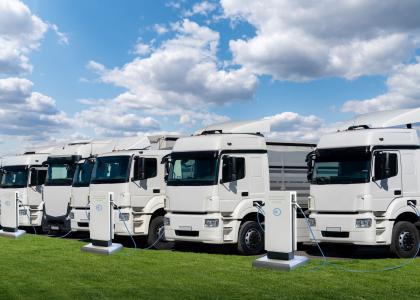The Environmental Protection Agency is taking the first of possibly several steps that could set back fuel efficiency for heavy-duty trucks, increase air pollution, and create market uncertainty for the trucking industry. At issue is the second phase of greenhouse gas emissions (GHG) standards for heavy-duty trucks, adopted in 2016. These standards are estimated to save 800,000 barrels of oil per day by 2040, thereby reducing fleet operating costs and hence the cost of goods.
Within the past week, the Office of Management and Budget received an EPA proposed rule to repeal emissions requirements for “glider vehicles”. A glider vehicle is a tractor chassis with frame, axle, cab, and brakes that becomes a highway truck when engine and transmission salvaged from earlier model years are installed. Repealing the glider provisions would allow trucking companies — contrary to Phase 2 of emissions standards — to install an older, outdated, high-emitting engine into a new truck body and avoid regulations that would apply to an entirely new truck.
This provision is especially damaging for air quality, since most glider manufacturers use remanufactured diesel engines from 2001 or earlier, which emit 20-40 times as much nitrogen oxide and particulate matter as today’s new diesel engines. Exposure to particulates can affect both our lungs and our hearts, while nitrogen oxide exposure could lead to development of asthma and increase respiratory infections.
The EPA has also said it plans to revisit the trailer standards in the Phase 2 program. EPA administrator Scott Pruitt, in August, wrote to the Tractor Trailer Manufacturing Association (TTMA): “EPA has decided to revisit the Phase 2 trailer provisions in general, and the issue of the EPA’s authority to regulate trailers in particular.” Meanwhile, TTMA has challenged the trailer provisions of the Phase 2 heavy-duty standards in court and asked for a stay order. Trailers account for a big chunk of the truck standards’ GHG savings, as we highlighted in a recent blog post. We estimate that, should the trailer standards get rolled back, future tractor-trailers would consume approximately 40,000 additional barrels of oil per day by 2025. Trailer standards rely on readily available technologies that pay for themselves within two years.
Aside from causing a sharp increase in air pollution, reopening the Phase 2 standards will introduce uncertainty to the industry. The American Trucking Association supported the successful Phase 1 rule and worked closely with EPA and the National Highway Traffic Safety Administration to build on that success with Phase 2. The association expressed concern that reopening Phase 2 could set the stage for California to impose a more stringent trailer standard. Indeed, California is already on track to adopt a state rule that will largely harmonize with the federal Phase 2 standards. “The lawsuit and reconsideration of the trailer provisions however, does not affect California’s authority to establish standards for trailers hauled by heavy‐duty tractors and CARB is accordingly proposing to establish specific requirements for trailers,” the California Air Resources Board asserted in a recent workshop. In the event of a federal rollback, California will consider new requirements on fleets operating in California that their trailers incorporate efficiency improvements that the Phase 2 program, as originally adopted, would have delivered.
Absent standards, many trailer manufacturers will decline to invest in efficiency improvements in a market where upfront cost and split incentives can blunt the demand for efficiency. Removing trailers from standards would also jeopardize a major remaining fuel efficiency opportunity, namely aerodynamic improvements through integration of tractor and advanced trailer. The Department of Energy’s SuperTruck program demonstrated that such integration could increase fuel savings by over 20% beyond Phase 2 levels. In the absence of trailer regulation, future standards will work hard to eke out 3-5% fuel savings from engine improvements while forgoing large, relatively low-cost savings from aerodynamics.



